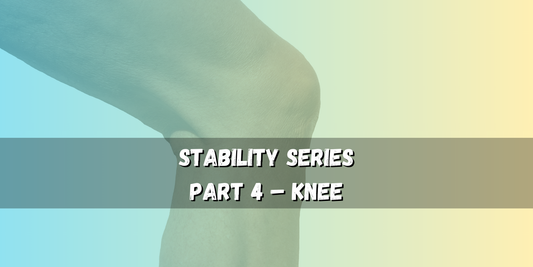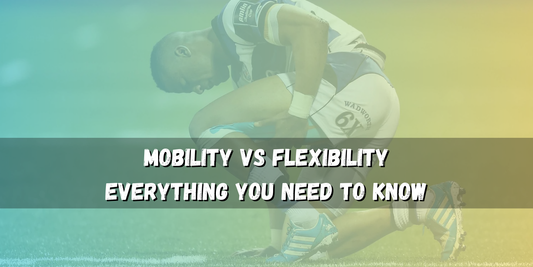Your wrists may be one of the smallest joints in your body—but in rugby, they play a massive role. From passing and catching to stiff-arming, rucking and bracing for contact, your wrists are constantly absorbing force and helping you stay in control. Without proper mobility and strength, you're more likely to experience dropped balls, limited range of motion, or even sprains and overuse injuries.
In Part 6 of our Mobility & Flexibility Series, we’re turning our attention to this often-overlooked joint and its role in performance, protection and control on the field.
Check out the rest of the series:
- Part 1: Hip Mobility – Unlock Power & Stability
- Part 2: Ankle Mobility – The Foundation of Speed & Agility
- Part 3: Thoracic Mobility – Essential for Movement & Control
- Part 4: Shoulder Mobility – Maximize Range & Strength
-
Part 5: Neck Mobility – Absorb Force & Protect Your Spine
Let’s dive in.
WHAT IS WRIST MOBILITY?
Wrist mobility refers to your ability to move your wrist through its full range of motion—flexion, extension, radial and ulnar deviation—without pain, tightness, or restriction.
In rugby, wrists are under constant stress. From passing and catching to tackling and falling, the ability to bend, absorb, and stabilize at the wrist joint is critical to performance and safety.
Good wrist mobility allows you to:
- Catch, pass, and carry the ball with greater control and confidence
- Protect your wrists during falls and tackles
- Apply stronger pressure in rucks, mauls, and scrums
- Reduce the risk of overuse injuries, including tendonitis and ligament strain
THE WRIST & FOREARM CONNECTION
Your wrists don’t work alone—they’re directly influenced by the surrounding musculature in your forearms, elbows, and even shoulders. Limited mobility or tightness anywhere in that chain can compromise your wrist mechanics.
Key Structures Affecting Wrist Mobility:
1. Forearm Flexors & Extensors
- Role: Control wrist bending and stabilization.
- When Tight or Weak? Reduces mobility and increases stress on the wrist joint.
2. Wrist Ligaments & Tendons
- Role: Provide stability and guide joint movement.
- When Overworked or Inflexible? Increases injury risk during contact.
3. Grip Muscles (Intrinsic Hand Muscles)
- Role: Help control fine motor skills and grip strength.
- When Underdeveloped? Limits ball control and leads to fatigue or overcompensation.
4. Elbow & Shoulder Mechanics
- Role: Affect the kinetic chain that ends at the wrist.
- When Dysfunctional? Forces the wrist to move inefficiently or absorb too much force.
WHY WRIST MOBILITY MATTERS FOR RUGBY PERFORMANCE
1. Stronger Ball Handling & Control
Better mobility means better hand positioning, faster passing, and more secure catches under pressure.
2. Safer Contact & Falls
Mobile wrists can absorb and redirect force, reducing the chance of sprains, dislocations, or fractures when bracing during contact or falling.
3. Improved Strength & Grip in Rucks & Tackles
Increased mobility enhances the ability to lock in strong grips and apply pressure, especially in mauls, rucks, and tackles.
4. Lower Risk of Chronic Pain & Overuse Injuries
Daily rugby demands lead to tight forearms, tendonitis, and wrist fatigue. Mobility training helps offset these repetitive stresses.
THE CHAIN REACTION: HOW POOR WRIST MOBILITY LEADS TO INJURY
When your wrists are stiff or weak, the effects ripple through your entire upper body:
- Tight Forearms → Reduced Wrist Range → Compensations in Shoulders & Elbows
- Weak Grip → Instability in Contact → Increased Risk of Sprains & Drops
- Poor Mobility → Bad Hand Positioning → Higher Chance of Fractures or Dislocations
This is especially common in young athletes who spend time lifting with poor form, falling incorrectly, or not training wrist strength at all.
THE WRIST MOBILITY ROUTINE EVERY RUGBY PLAYER NEEDS
Here’s a simple, effective 3-step routine to improve your wrist mobility and control:
Step 1: Soft Tissue Release (2-3 Minutes)
- Goal: Release forearm tension and improve circulation.
- Tools: Lacrosse ball, forearm massage stick.
- Focus Areas: Flexors, extensors, and forearm fascia.
Step 2: Wrist Mobility Drills (5-7 Minutes)
- Goal: Improve range of motion and joint control.
- Exercises: Wrist Circles (All Directions), Palm-Down Wrist Rocks (On Floor), Wrist Extension Holds Against Wall, Fingertip Push-ups (Regressed if needed)
Step 3: Strength & Activation (3-5 Minutes)
- Goal: Build control and durability.
- Exercises: Wrist Curls & Reverse Curls (Light Weight), Grip Squeeze Holds (Using Stress Ball or Gripper), Isometric Wrist Holds in Various Angles
WATCH THE FULL ROUTINE
We’ve put together the full wrist mobility routine on our YouTube channel, guiding you through release work, mobility drills, and activation exercises.
Check out the Wrist Mobility Routine below:
FINAL THOUGHTS
Improving wrist mobility is about more than flexibility—it’s about functional strength, better control, and long-term durability.
- Stronger ball handling
- More resilient wrists in contact
- Lower risk of injury and downtime
Start today. Your wrists (and your hands) will thank you on the field.
Need More Help?
Check out our Rugby Workout Plans and Customized Training Programs to build a stronger, more resilient body.
This wraps up Part 6 of our Mobility & Flexibility Series: Wrist Mobility. If you found this post helpful, make sure to:
- Like and share this post with fellow rugby players
- Bookmark the blog to stay updated on the next parts of the series
-
Follow Peak Rugby on X, Facebook and subscribe to the YouTube Channel for more rugby-specific training, mobility, and recovery tips.
Stay strong, keep pushing forward, and keep working on your mobility!


















